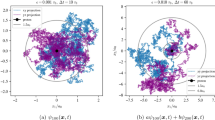Abstract
The problem of the ground state of the electronic system in the Hubbard model for U=∞ is discussed. The author investigates the normal (singlet or nonmagnetic) N state of the electronic system over the entire range of electron densities n⩽1. It is shown that the energy of the N state ɛ (1)0 (n) in a one-particle approximation, such as (e.g.) the extended Hartree-Fock approximation, is lower than the energy of the saturated ferromagnetic FM state ɛ FM(n) for all n. The dynamic magnetic susceptibility is calculated in the random phase approximation, and it is shown that the N state is stable over the entire range of electron densities: The static susceptibility (ω=0) does not have a band singularity in the zero-wave vector limit q→0. A formally exact representation is obtained for the mass operator of the one-particle Green’s function, and an approximation of this operator is proposed: M k(E)⋍λF(E), where λ=n(1−n)/(1−n/2)z is the kinematic interaction parameter, z is the number of nearest neighbors, and F(E) is the total single-site Green’s function. For an elliptical density of states the integral equation for F(E) is solved exactly, ad it is shown that the spectral intensity rigorously satisfies the sum rule. The calculated energy of the strongly correlated N state ɛ 0(n)<ɛ FM(n) for all n, and in light of this relationship the author discusses the hypothesis that the ground state of the system is the normal (singlet) state in the thermodynamic limit. The electron distribution function at T=0 differs significantly from the Fermi step; it is “smeared” along the entire energy spectrum, and discontinuities do not occur in the region of the chemical potential m.
Similar content being viewed by others
References
J. Hubbard, Proc. R. Soc. London Ser. A 276, 238 (1963); 277, 237 (1964); 281, 401 (1964).
Yu. A. Izyumov and Yu. N. Skryabin, Statistical Mechanics of Magnetically Ordered Systems [in Russian], Moscow (1987).
Yu. A. Izyumov, M. I. Katsnel’son, and Yu. N. Skryabin, Itinerant Electron Magnetism [in Russian], Moscow (1994).
Yu. A. Izyumov, Usp. Fiz. Nauk 161(11), 1 (1991) [Sov. Phys. Usp. 34, 935 (1991)].
Yu. A. Izyumov, Usp. Fiz. Nauk 165, 403 (1995) [Phys. Usp. 38, 385 (1995)].
E. H. Lieb, in Proceedings of the Conference on Advances in Dynamical Systems and Quantum Physics (Capri, May, 1993), World Scientific Publ. (1993), pp. 1–19.
E. H. Lieb and F. Y. Wu, Phys. Rev. Lett. 20, 1445 (1968).
Y. Nagaoka, Phys. Rev. 147, 392 (1966).
G. S. Tian, J. Phys. A 23, 2231 (1993).
B. Doucot and X. G. Wen, Phys. Rev. B 40, 2719 (1989).
Y. Fang, A E. Ruckenstein, E. Dagotto, and S. Schmitt-Rink, Phys. Rev. B 40, 7406 (1989).
A. Sütó, Commun. Math. Phys. 140, 43 (1991).
B. To’th, Lett. Math. Phys. 22, 321 (1991).
E. V. Kuz’min, Pis’ma Zh. Éksp. Teor. Fiz. 57, 575 (1993).
M. Takahashi, J. Phys. Soc. Jpn. 47, 47 (1989).
J. Callaway, D. R. Chen, and R. Tang, Phys. Rev. B 35, 3705 (1987).
J. A. Riera and A. P. Young, Phys. Rev. B 40, 5285 (1989).
B. S. Shastry, H. R. Krishnamurthy, and P. W. Anderson, Phys. Rev. B 41, 2375 (1990).
W. von der Linden and D. M. Edwards, J. Phys. Condens. Matter 3, 4917 (1991).
T. Hanish and E. Müller-Hartmann, Ann. Phys. (Leipzig) 2, 381 (1993).
N. N. Bogolyubov, Selected Works [in Russian], Vol. 3, Kiev (1971).
S. V. Tyablikov, Methods of the Quantum Theory of Magnetism [in Russian], Moscow (1975).
E. G. Goryachev and E. V. Kuzmin, Phys. Lett. 137, 423 (1989); Phys. Lett. 149, 60 (1990).
E. G. Goryachev and E. V. Kuz’min, Teor. Mat. Fiz. 85, 412 (1990).
E. G. Goryachev and E. V. Kuz’min, Pis’ma Zh. Éksp. Teor. Fiz. 52, 949 (1990).
D. N. Zubarev and Yu. G. Rudoi, Usp. Fiz. Nauk 163(3), 103 (1993) [Phys. Usp. 36, 188 (1993)].
J. Hubbard and K. P. Jain, J. Phys. C 1, 1650 (1968).
E. V. Kuz’min, Fiz. Met. Metalloved. 81, 33 (1996).
D. Pines and P. Nozières, Theory of Quantum Liquids, Benjamin, New York (1966).
F. D. M. Haldane, J. Phys. C 14, 2585 (1981).
P. W. Anderson, Phys. Rev. Lett. 64, 1839 (1990).
C. Varma, P. Littlewood, S. Schmitt-Rink et al., Phys. Rev. Lett. 63, 1996 (1989).
G. E. Volovik, Pis’ma Zh. Éksp. Teor. Fiz. 53, 208 (1991).
Author information
Authors and Affiliations
Additional information
Fiz. Tverd. Tela (St. Petersburg) 39, 193–203 (February 1997)
Rights and permissions
About this article
Cite this article
Kuz’min, E.V. The ground state problem in the infinite-U Hubbard model. Phys. Solid State 39, 169–178 (1997). https://doi.org/10.1134/1.1130126
Received:
Revised:
Issue Date:
DOI: https://doi.org/10.1134/1.1130126




